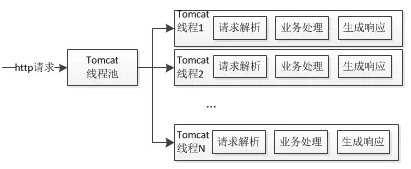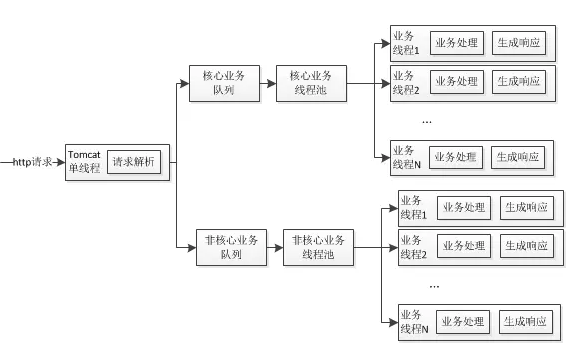Servlet3之NIO线程池隔离
线程隔离主要是针对业务中不同业务场景,按照权重区分使用不同的线程池,以达到某一个业务出现问题,不会将故障扩散到其他的业务线程池,从而达到保证主要业务高可用。
本案例主要讲解基于servlet3的线程隔离术。
首先我们回忆一下在tomcat6,tomcat6只支持BIO,它的处理流程如下:
1).tomcat负责接收servletRequest请求
2).将接收的请求分配给servlet处理业务
3).处理完请求之后,通过servletResponse写会数据
上面这三步都是在一个线程里面完成的,也就是同步进行。
如下图:

tomcat7之后版本引入了servlet3,它基于NIO能处理更大的并发数。
我们可以将整个请求改造成如下步骤:
1).tomcat单线程进行请求解析
2).解析完之后将task放入队列(可以根据不同业务类型放入不同的队列)
3).每个队列指定相应业务线程池对task进行处理
这样改造以后就可以把业务按照重要性发送到不同线程池,两个线程池分开独立配置,互不干扰。当非核心的业务出现问题之后,不会影响核心的业务。另外由于此线程池是有我们创建的,我们可以对该线程池进行监控,处理,灵活了很多。
如下图:

下面是实现代码:
接口层调用
@RestController
@RequestMapping("/app")
public class NIOCtrl {
@Autowired
private LocalNewsAsyncContext localNewsAsyncContext;
@Autowired
private NewsService newsService;
@RequestMapping("/news")
public void getNews(HttpServletRequest request,@RequestParam(value = "type",required = false) String type){
if("1".equals(type)){
localNewsAsyncContext.submit(request, () -> newsService.getNews());
return;
}
localNewsAsyncContext.submit(request, () -> newsService.getNewsMap());
}
}
将请求丢进指定线程池
@Service
public class LocalNewsAsyncContext {
private final static Long timeOutSeconds= 5L;
@Autowired
private CustomAsyncListener asyncListener;
@Autowired
private ThreadPoolExecutor executor;
public void submit(final HttpServletRequest request,final Callable<Object> task){
final String uri= request.getRequestURI();
final Map<String,String[]> params= request.getParameterMap();
//开启异步上下文
final AsyncContext asyncContext= request.startAsync();
asyncContext.getRequest().setAttribute(Constant.URI,uri);
asyncContext.getRequest().setAttribute(Constant.PARAMS, params);
asyncContext.setTimeout(timeOutSeconds * 1000);
if(asyncContext!=null){
asyncContext.addListener(asyncListener);
}
executor.submit(new CustomCallable(asyncContext, task));
}
}
自定义线程处理
public class CustomCallable implements Callable{
private static final Logger LOG = LoggerFactory.getLogger(CustomCallable.class);
public AsyncContext asyncContext;
private Callable<Object> task;
private String uri;
private Map<String,String[]> params;
public CustomCallable(AsyncContext asyncContext, Callable<Object> task){
this.asyncContext= asyncContext;
this.task= task;
this.uri= (String) asyncContext.getRequest().getAttribute(Constant.URI);
this.params= (Map<String, String[]>) asyncContext.getRequest().getAttribute(Constant.PARAMS);
}
@Override public Object call() throws Exception {
Object o= task.call();
if(o==null){
callback(asyncContext,o);
}else if(o instanceof String){
callback(asyncContext, o);
}else if(o instanceof CompletableFuture){
CompletableFuture<Object> future= (CompletableFuture<Object>) o;
future.thenAccept(o1 -> callback(asyncContext, o1))
.exceptionally(throwable -> {
callback(asyncContext,"");
return null;
});
}else {
callback(asyncContext, o);
}
return null;
}
private void callback(AsyncContext asyncContext,Object result){
HttpServletResponse response= (HttpServletResponse) asyncContext.getResponse();
try{
if(result instanceof String){
write(response, (String) result);
}else {
write(response, JSON.toJSONString(result));
}
}catch (Exception e){
response.setStatus(HttpServletResponse.SC_INTERNAL_SERVER_ERROR);
e.printStackTrace();
try {
LOG.error("get info error for uri:{}, params:{}",uri,JSON.toJSONString(params),e);
}catch (Exception e1){}
}finally {
asyncContext.complete();
}
}
private void write(HttpServletResponse response,String result) throws IOException {
response.getOutputStream().write(result.getBytes());
}
}
定义业务线程池
@Configuration
public class LocalNewsPoolConfig {
private final static Logger LOG= LoggerFactory.getLogger(LocalNewsPoolConfig.class);
@Bean
public ThreadPoolExecutor init(){
int corePoolSize= 10;
int maximumPoolSize= 100;
int queueCapacity= 200;
LinkedBlockingDeque<Runnable> queue= new LinkedBlockingDeque<>(queueCapacity);
ThreadPoolExecutor executor= new ThreadPoolExecutor(corePoolSize,maximumPoolSize,60L, TimeUnit.SECONDS,queue);
executor.allowCoreThreadTimeOut(true);
executor.setRejectedExecutionHandler((r, executor1) -> {
if(r instanceof CustomCallable){
CustomCallable call= (CustomCallable) r;
AsyncContext asyncContext= call.asyncContext;
if(asyncContext!=null){
handler(asyncContext);
}
}
});
return executor;
}
private static void handler(AsyncContext asyncContext){
try{
ServletRequest req= asyncContext.getRequest();
String uri= (String) req.getAttribute(Constant.URI);
Map params= (Map) req.getAttribute(Constant.PARAMS);
LOG.error("async req rejected. uri :{},params:{}",uri, JSON.toJSONString(params));
}catch (Exception e){
e.printStackTrace();
try{
HttpServletResponse response= (HttpServletResponse) asyncContext.getResponse();
response.setStatus(HttpServletResponse.SC_INTERNAL_SERVER_ERROR);
}catch (Exception e1){}
}finally {
asyncContext.complete();
}
}
}
定义异步请求监听
@Component
public class CustomAsyncListener implements AsyncListener {
private Logger LOG= LoggerFactory.getLogger(CustomAsyncListener.class);
@Override public void onComplete(AsyncEvent asyncEvent) throws IOException {
}
@Override public void onTimeout(AsyncEvent asyncEvent) throws IOException {
AsyncContext asyncContext= asyncEvent.getAsyncContext();
try{
ServletRequest req= asyncContext.getRequest();
String uri= (String) req.getAttribute(Constant.URI);
Map params= (Map) req.getAttribute(Constant.PARAMS);
LOG.error("async req timeOut. uri :{},params:{}",uri, JSON.toJSONString(params));
}catch (Exception e){
e.printStackTrace();
}finally {
try{
HttpServletResponse response= (HttpServletResponse) asyncContext.getResponse();
response.setStatus(HttpServletResponse.SC_REQUEST_TIMEOUT);
}catch (Exception e1){}
asyncContext.complete();
}
}
@Override public void onError(AsyncEvent asyncEvent) throws IOException {
AsyncContext asyncContext= asyncEvent.getAsyncContext();
try{
ServletRequest req= asyncContext.getRequest();
String uri= (String) req.getAttribute(Constant.URI);
Map params= (Map) req.getAttribute(Constant.PARAMS);
LOG.error("async req error. uri :{},params:{}",uri, JSON.toJSONString(params));
}catch (Exception e){
e.printStackTrace();
try{
HttpServletResponse response= (HttpServletResponse) asyncContext.getResponse();
response.setStatus(HttpServletResponse.SC_INTERNAL_SERVER_ERROR);
}catch (Exception e1){}
}finally {
asyncContext.complete();
}
}
@Override public void onStartAsync(AsyncEvent asyncEvent) throws IOException {
}
}
业务处理和常量类
@Service
public class NewsService {
public String getNews(){
return "servlet3 nio test.";
}
public StringBuilder getNewsMap(){
return new StringBuilder("I do and i understand.");
}
}
public class Constant {
public static final String URI= "uri";
public static final String PARAMS= "params";
}
来源:https://www.jianshu.com/p/0529c126e166?utm_campaign
正文到此结束
- 本文标签: 数据 json build queue id js 解析 ThreadPoolExecutor 线程池 IO https UI HTML 同步 ACE NIO tomcat 配置 App setTimeout http executor 并发 servlet map CTO final ask ioc stream db cat CEO REST DDL bean BIO tab 线程 代码 list core constant equals tar IDE value src Service 高可用
- 版权声明: 本文为互联网转载文章,出处已在文章中说明(部分除外)。如果侵权,请联系本站长删除,谢谢。
- 本文海报: 生成海报一 生成海报二
热门推荐
相关文章
Loading...











![[HBLOG]公众号](https://www.liuhaihua.cn/img/qrcode_gzh.jpg)

